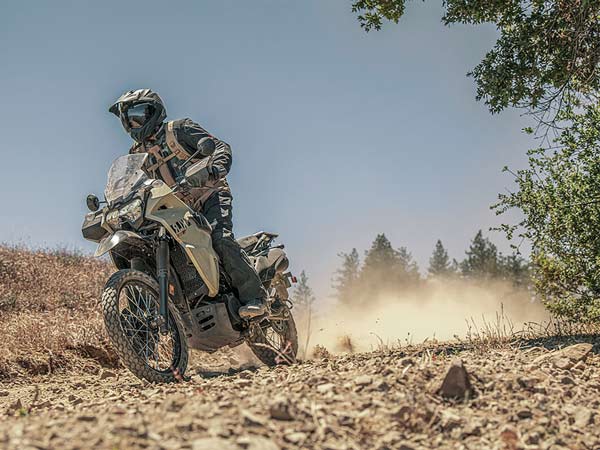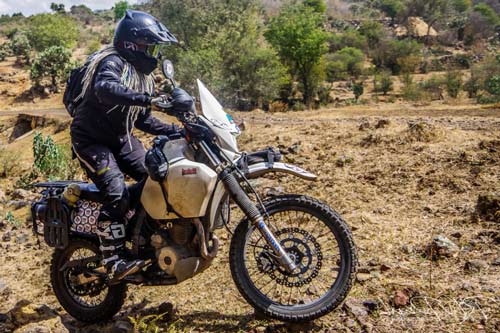I prefer a dual sport bike because it allows a rider to have a smooth on-road drive and the agility needed for off-road driving. The Suzuki DR650 and Kawasaki KLR650 are among the two popular choices for dual-sport motorcycles.
But how do Suzuki DR650 and Kawasaki KLR650 compare? For a start, the two bikes differ in engine displacement, with Kawasaki having 651cc and the Suzuki DR650 644cc. The Suzuki DR650, the newer of the two bikes, edges in reliability and agility. The Kawasaki leads in comfort.
While the two bikes are a top choice, each can suit certain riders differently than it might others. Read on for a better understanding as I compare the two bikes in-depth.
Suzuki DR650 vs Kawasaki KLR650: Features Comparison Table
The following table compares my two favorite bikes, the Suzuki DR650 and Kawasaki KLR650.
| Specs | Suzuki DR650 | Kawasaki DR650 |
| Displacement | 644cc | 651cc |
| Horsepower | 43hp | 34.61hp |
| Torque | 32.2 lbs. ft | 33.5 lbs. Ft |
| Weight | 366 lb. | 489 lb. |
| Travel | 10.2 inch | 7.2 inch |
| Seat height | 34.8 in | 32.1 in |
| Fuel capacity | 13L (3.4 Us gallons) | 23L (6 Us gallons) |
Engine Power and Performance
Both bikes’ engines are reliable and powerful and can make enough power to ride over 80mph. Both engines are four-stroke, single-cylinder, with the Kawasaki engine making 651cc while the Suzuki makes 644cc.
The engine power is, however, different, with the 2022 KLR650 having 34.61 hp while the DR650 has 43hp. The torque on the Kawasaki is 33.5 lbs. ftand 32.2 lbs. ft on the Suzuki. The torque is not that far apart, but the higher torque in Kawasaki makes it more efficient.

Another notable difference between the two bikes’ engines is the cooling method. The Suzuki DR650 is air or oil cooled, while the Kawasaki KLR is liquid-cooled. Each cooling method has pros and cons, with the liquid-cooled being more effective though prone to leakages.
As a person who fancies agile rides, I find more horsepower on the Suzuki vital, especially on a racing track. Despite the slow start on the Kawasaki, it’s more stable on long distances with fewer vibrations.
Weight and Handling
One thing I always check on a bike is its comfort because if the rider is uncomfortable, they can’t enjoy other features. One thing that needs replacing almost straight away on the two bikes is the stock handlebars. They are too low, and unless adjusted, it may feel uncomfortable to some riders.
The Kawasaki KLR650 is the heavier of the two bikes as it contains more parts and accessories. The 2023 Kawasaki has a curb weight of 489 lb., while the Suzuki DR650 is 366 lb. The extra weight can contribute to handling difficulties, especially when driving off-road.
However, I find the extra weight ideal for highway driving, where the weight is barely a problem.
The Kawasaki bike is also more comfortable with a plush and welcoming seat. The accessories protect the rider against wind, making speed rides bearable. The rider is exposed on Suzuki, which is an advantage when driving off-road as it allows better handling.
Luckily, there are plenty of aftermarket parts available for both bikes to improve handling. Some of the aftermarket parts that are ideal are the handlebars and bar raisers that make you more comfortable when riding.
Suspension
The Kawasaki KLR650 has non-adjustable Telescopic 41mm fork front suspensions with 200mm travel. The rear unitrack monoshock suspensions are adjustable for preload and rebound and have 185mm travel.
Both front and rear suspensions in the Suzuki DR650 are coil spring oil damped and adjustable. Both bikes’ suspensions also provide 260mm (10.2-inch travel,) which comes in handy in off-road terrain.

Both suspensions can easily take the abuse from the off-road terrain and help maintain stability and control. The adjustable suspension helps improve the riding quality by increasing or reducing the hardness to suit your preferred riding type.
Of the two bikes, the Kawasaki KLR650 has ABS, which improves braking significantly. The braking is just fine on the rear wheel but a little so on the front. However, the 290mm front and 240mm disc rear brakes on Suzuki are reliable when needed.
The Suzuki DR650 features Bridgestone tires which are excellent for both on-road and off-road driving. The tire sizes are 90/90-21 for the front wheel and 120/90-17 for the rear.
The Kawasaki on the other hand uses the Dunlop K750 for the wheels. Its sizes are 90/90-21 for the front tire and 130/80-17 for the rear tires.
Dimensions & Chassis
Dimension is another crucial feature when determining the bike to use. If you fancy agile trail riding, you will go for a narrower and lighter bike. The Suzuki DR650 is 88 inches long, 34.1 inches wide, and 47.0 inches height.
The Kawasaki KLR650 is 89.8-inch length, 38.2 inches wide, and 57.3 inches high. The small dimension of the Suzuki makes it ideal for trail rides.
I also prefer a bike with a variety of colour options, the Suzuki has solid black, iron grey, or solid special white No.2 colours. The Kawasaki KLR650 is available in pearl storm grey and Candy lime green for the non-ABS model.
Other Notable Features:
Other features you can use to determine the bike to use include;
Fuel capacity
The Kawasaki KLR650 has a larger fuel tank carrying about 23 litres (6 Us gallons.) The Suzuki DR650 carries 13L (3.4 Us gallons,) which is lower and affects long-distance travel. However, aftermarket gas tanks can be used for more capacity.
Seat height
The seat height of the two bikes differs by at least two inches, with the Suzuki having a higher of 34.8 inches. The height on the two bikes is adjustable to match the driver’s requirements.
Wheelbase
The Kawasaki KLR650 has a wheelbase of 60.6 inches, while the Suzuki DR650 has 56.9 inches. As the wheelbase contributes to comfort, the Kawasaki is deemed as the more comfortable of the two.
Exhaust/mufflers
Both bikes are fitted with mufflers that are part of their exhaust system. However, most people change them to aftermarket mufflers which are better and bigger.
Common Issues
Both the Suzuki DR650 and the Kawasaki KLR650 are known to have some vibration at higher speeds which may loosen some nuts. However, vibrations can be mitigated by adding heavier flywheels or handlebar weights.
Gen 2 Kawasaki KLR reported oil-burning problems, which is related to poor seating rings or cylinder bores. The adjuster chain on the KLR is also known to destroy the engine, a problem known as the “doohickey” problem.
The earlier DR650 models are known to leak oil due to the use of paper gaskets used. The solutions involve changing the gasket with a metal-based one. The NSU screws, neutral sending unit, is also known to become loose with time.
FAQ
The following section covers frequently asked questions and answers on Suzuki and Kawasaki 650. They include;
Which Choice, Between Suzuki DR650 and Kawasaki KLR650, Is Better Off-road?
The Suzuki DR650 is often the better choice of the two bikes when driving off-road. I find the larger ground clearance and power ideal for this terrain.
Which Option, Between Suzuki DR650 and Kawasaki KLR650, is Better For Load Trips?
Both bikes are capable of road trips, but with stock parts, the Kawasaki KLR650 is often the better choice. The larger tank capacity and the comfortable seats are among the qualities that make the bike more capable.
What, Between Suzuki DR650 and Kawasaki KLR650 Have More Mileage?
Both Suzuki and Kawasaki bikes can have long mileage depending on the amount of maintenance and how they’re taken care of. However, most owners of these bikes say the Suzuki parts are more durable, with fewer chances of failure, and can last longer.
Final Verdict
Suzuki DR650 and Kawasaki KLR650 are undoubtedly among the top options for dual sport bikes. The bikes are powerful and capable of achieving and maintaining high speeds. However, the Suzuki has more horsepower and better handling.
I can’t tell you the bike to choose, as your riding style affects the decision. If you fancy off-road and agile riding, the Suzuki DR650 will do you justice. However, if you want a touring bike with off-road capabilities, then the Kawasaki KLR650 is your bike.